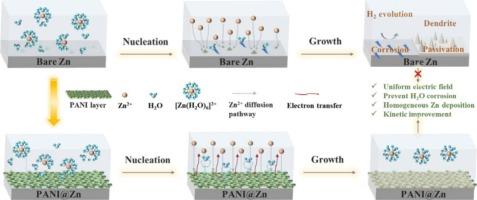Interfacial electric field and desolvation regulation via conducting polymer interphase enables stable zinc anode
IF 13.2
1区 工程技术
Q1 ENGINEERING, CHEMICAL
引用次数: 0
Abstract
Practical implementation of Zn metal anodes boasting high volumetric capacity is significantly limited by dendritic growth and associated interfacial parasitic reactions. In this paper, the conductive polymer PANI is rationally designed as an interfacial layer to regulate the Zn2+ deposition to obtain a stable Zn anode. Finite element simulations and experiments reveal that PANI accelerates the Zn2+ transport kinetics via Coulombic gravity during the deposition/stripping process, which results in uniform interfacial charge distribution and Zn deposition. Furthermore, Electrochemical analysis and density-functional theory (DFT) calculations indicate that the amine (-NH-) and imine (-N=) groups on the PANI chains immobilize the H2O molecules near Zn2+, which effectively reduced the migration energy barrier of Zn2+ by facilitating desolvation of Zn2+. Therefore, the PANI layer enables uniform Zn deposition via synergistic interfacial electric field effects and controlled Zn2+ desolvation. The PANI@Zn anode achieves a high average Coulombic efficiency of 99.5 % over 750 cycles. Additionally, the PANI@Zn//MnO2 full cell delivers stable cycling for 2000 cycles at 1 A g−1. This study offers novel insights into conducting polymer interphases for high-performance Zn-ion batteries.

界面电场和通过导电聚合物界面调节脱溶,使锌阳极稳定
具有高容量的锌金属阳极的实际实施受到枝晶生长和相关的界面寄生反应的显著限制。本文合理设计导电聚合物聚苯胺作为界面层,调节Zn2+沉积,获得稳定的Zn阳极。有限元模拟和实验结果表明,聚苯胺加速了沉积/剥离过程中Zn2+的库仑重力输运动力学,使界面电荷分布均匀,Zn沉积均匀。此外,电化学分析和密度泛函理论(DFT)计算表明,PANI链上的胺(- nh -)和亚胺(- n =)基团固定了Zn2+附近的H2O分子,通过促进Zn2+的脱溶,有效降低了Zn2+的迁移能垒。因此,聚苯胺层通过协同界面电场效应和控制Zn2+的脱溶,实现了均匀的Zn沉积。PANI@Zn阳极在750 次循环中达到99.5 %的高平均库仑效率。此外,PANI@Zn//MnO2全电池在1 A g−1下可稳定循环2000 次。本研究为高性能锌离子电池的导电聚合物界面提供了新的见解。
本文章由计算机程序翻译,如有差异,请以英文原文为准。
求助全文
约1分钟内获得全文
求助全文
来源期刊

Chemical Engineering Journal
工程技术-工程:化工
CiteScore
21.70
自引率
9.30%
发文量
6781
审稿时长
2.4 months
期刊介绍:
The Chemical Engineering Journal is an international research journal that invites contributions of original and novel fundamental research. It aims to provide an international platform for presenting original fundamental research, interpretative reviews, and discussions on new developments in chemical engineering. The journal welcomes papers that describe novel theory and its practical application, as well as those that demonstrate the transfer of techniques from other disciplines. It also welcomes reports on carefully conducted experimental work that is soundly interpreted. The main focus of the journal is on original and rigorous research results that have broad significance. The Catalysis section within the Chemical Engineering Journal focuses specifically on Experimental and Theoretical studies in the fields of heterogeneous catalysis, molecular catalysis, and biocatalysis. These studies have industrial impact on various sectors such as chemicals, energy, materials, foods, healthcare, and environmental protection.
 求助内容:
求助内容: 应助结果提醒方式:
应助结果提醒方式:


